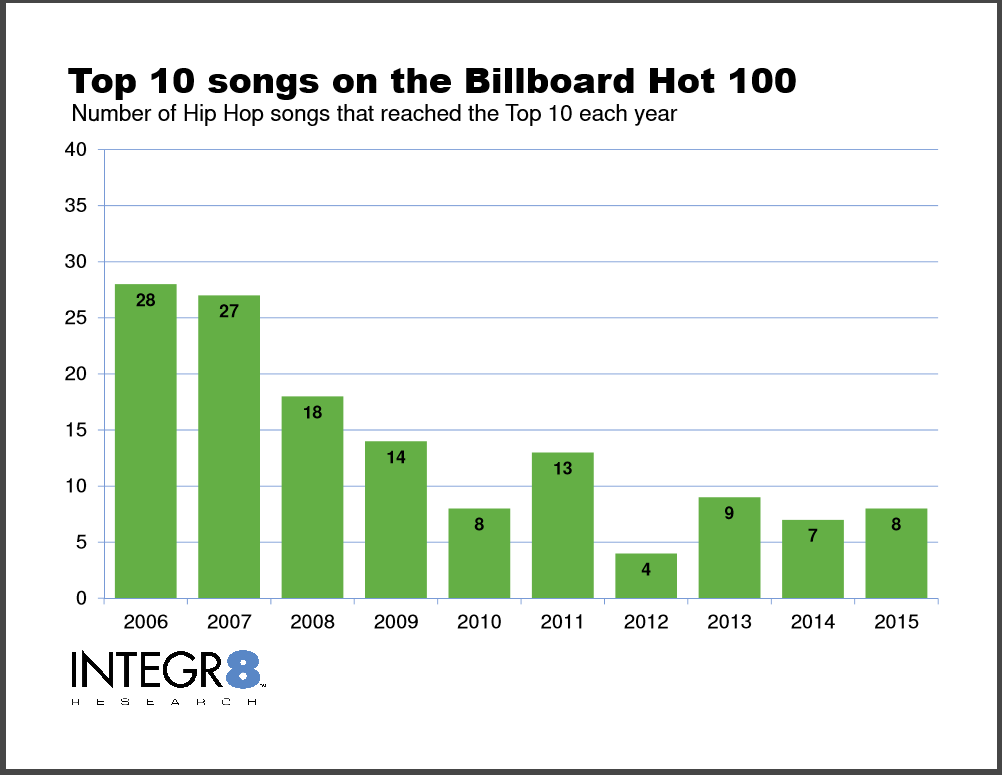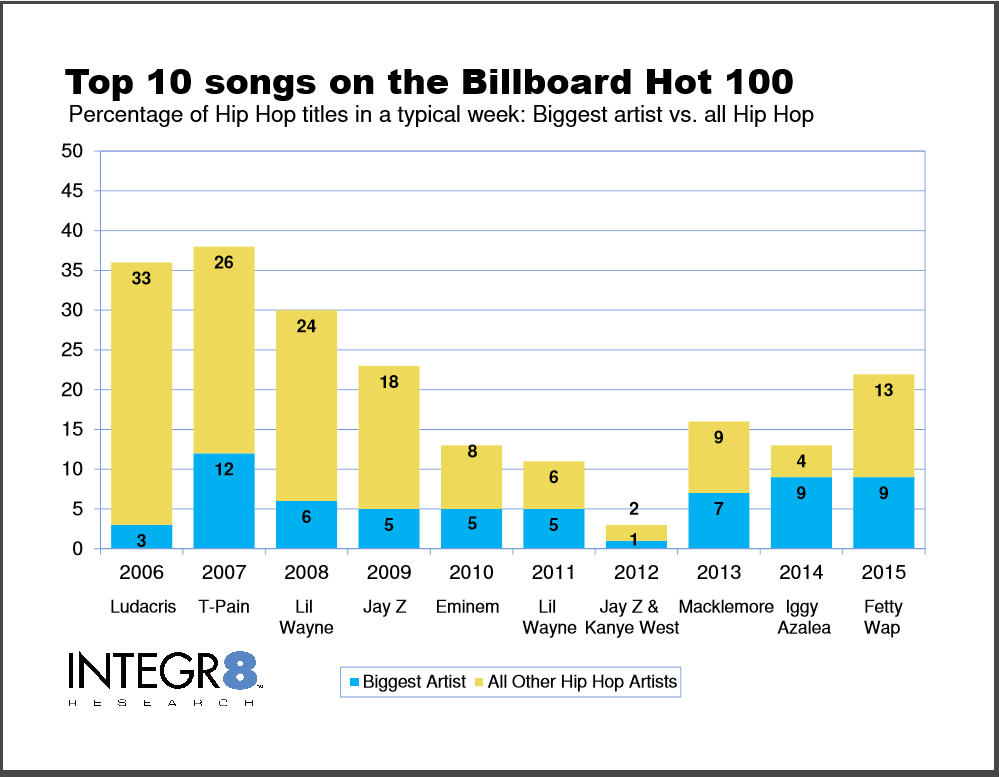In our last post, we explored the fall and rise of Hip Hop, shown as Hip Hop’s share of the top 10 songs on the Billboard Hot 100 each week. Although Hip Hop’s appeal has rebounded back to 2008 levels after reaching a low point in 2012, there are three fundamental differences between Hip Hop’s appeal from 2000 to 2012 and Hip Hop’s appeal from 2012 to today.
1. Fewer titles are becoming Top 10 hits, but they’re staying hits longer.
First, far fewer individual Hip Hop titles are actually making it into the Billboard Hot 100’s Top 10 today. In 2006, 28 different Hip Hop titles were Top 10 hits, but on average, these songs remained in the Top 10 for seven weeks. In 2015, only eight reached the Top 10. However, those eight songs that did reach the Top 10 remained there for 13 weeks on average. Fetty Wap’s “Trap Queen” stayed in the Hot 100’s Top 10 for 25 weeks. There are fewer Hip Hop songs becoming big hits today, but the songs that do make it have much stronger staying power than the Hip Hop hits from a few years ago.
Figure 1: Number of Hip Hop songs that reached the Top 10 each year
2. Even fewer artists have big Hip Hop hits today.
Second, far fewer Hip Hop artists are scoring Top 10 hits on the Billboard Hot 100. From 2005 through 2011, a wide variety of artists, including Ludacris, Nelly, Flo Rida, T-Pain, Usher, Lil Wayne, T.I., Jay-Z, Drake, and Wiz Khalifa accounted for Hip Hop’s biggest hits each year.
In 2013, however, almost half of the Top 10 Hip Hop hits during a typical week were from only one artist: Macklemore. Not only was the year’s biggest Hip Hop hit by a Caucasian from Seattle, “Thrift Shop” blatantly mocked the materialistic, big-spending lifestyle celebrated in Hip Hop’s biggest hits of the previous decade.
In 2014, a whopping 71% of Hip Hop’s time in the Top 10 came from one Australian artist who learned to rap from a native of Atlanta: Iggy Azalea’s “Fancy,” “Problem,” and “Black Widow,” spent a combined 46 weeks in the Top 10 of the Billboard Hot 100 chart. In comparison, Chris Brown and Lil Wayne only managed two weeks.
In 2015, while Hip Hop’s share of the Top 10 on a typical week rose, 41% of Hip Hop’s time in the Top 10 came from Fetty Wap’s three hits last year.
This change from a variety of artists with a library of hits to only a handful of artists with a small number of specific hits has benefitted Mainstream CHRs more than many Rhythmic CHRs for whom historically Hip Hop was a core sound. There aren’t as many second-tier Hip Hop hits with general market appeal for a Rhythmic CHR to play prominently in regular rotation, while the biggest Hip Hop hits are so big, mainstream CHR outlets often get the perceptual credit for playing them.
For Rhythmic CHR outlets that depend on general market ratings success, balancing playing the biggest current hits with playing the songs that listeners perceive make the station uniquely different than the mainstream CHR is more critical and challenging than ever. Some stations will find it’s better to err on the side of playing more pop and dance hits instead of Hip Hop. Other Rhythmic CHRs will be better off dipping deeper into urban material to stay true to listeners’ expectations of the brand. That strategic decision depends on the competitive situation and market composition for each individual Rhythmic CHR. With fewer Hip Hop titles and artists enjoying mass appeal, following the Rhythmic CHR formulas that worked a decade ago isn’t an option today.
Figure 2: Percentage of Hip Hop titles in a typical week for the year’s biggest Hip Hop artist vs. all Hip Hop titles in the Top 10 in a typical week
3. Hip Hop is no longer an isolated genre.
Third, unlike a decade ago, today’s young hit music consumers don’t see Hip Hop as a separate and isolated genre, but rather as another popular style that can be blended in songs with others like pop and EDM.
Take “See You Again” from Wiz Khalifa featuring Charlie Puth, which was 2015’s second biggest Hip Hop hit. It combines Rap with a love song chorus so smooth you’d think it was written for Delilah. We didn’t even count Taylor Swift’s “Bad Blood” as Hip Hop in our analysis, since the Hot AC version didn’t include Kendrick Lamar, but 2015’s CHR listeners didn’t bat an eye at the pairing. Can you imagine Shania Twain and P Diddy recording together in 1999?
2016 continues the trend of Hip Hop becoming a stylistic component of hit songs rather than a distinct genre. Rihanna and Drake both had Hip Hop and non-Hip Hop hits, most notably their joint effort “Work.” Some songs we categorized as Hip Hop, such as G-Eazy and Bebe Rexha’s “Me, Myself & I” or “One Dance” from Drake featuring Wizkid and Kyla, could just as easily been counted as Dance or R&B hits.
For Urban Contemporary radio, Hip Hop remains a distinct genre with big hits by a new generation of stars, from Fetty Wap and Schoolboy Q to Desiigner and Bryson Tiller. However, among general market audiences, this pure Hip Hop is highly polarizing: Some listeners love it, but as we see in our Integr8 New Music Research for CHR clients, a significant number of listeners also hate this kind of Hip Hop.
In contrast, the Hip Hop tracks that have become huge mainstream hits since 2012 have largely been songs that break down the barriers that traditionally defined Hip Hop, whether it be the background of the performers, the mixing of musical styles or the lyrical content of the song. No, Hip Hop didn’t die in 2012. However, the assumptions we used to make about what defines Hip Hop should.


